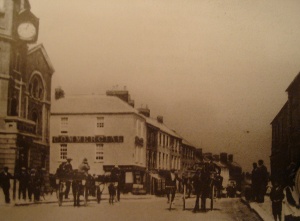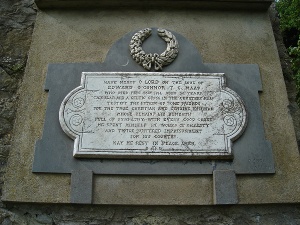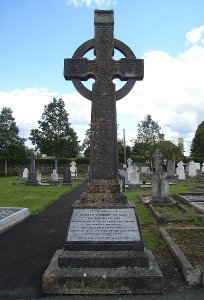Edward O’Connor
Published in the Kildare Nationalist in two parts
26th June 2009, 3rd July 2009
Edward O’Connor (1848–1884) was a popular Naas town commissioner in the 1880’s. He is regarded as a mystery man with very little known about him except the fact that there is a large memorial erected to his memory in St. Corban’s Cemetery, Naas.
O’Connor was born in Ballinafagh just outside Prosperous in 1848 where his family were substantial tenant farmers. As a young man and an only son he decided not to go into farming but instead chose a career as a publican.
As a teenager in the autumn of 1865 when he was serving his apprenticeship in Dublin he became involved in the Fenian conspiracy. The following spring he was back living in Ballinafagh and came under suspicion from the local RIC who obtained certain information that linked him to Fenian activity. On the evening of 28 February 1866, the RIC from Robertstown and Donadea searched the O’Connor residence at Ballinafagh and Edward was taken into custody. At the same time another local man, Joseph Cooney, from Ballagh was also arrested and they were both taken to Naas jail. The RIC found an incriminating letter in a trouser pocket belonging to O’Connor. The letter was addressed to O’Connor and came from an associate in Dublin named Myles Byrne. It related to recent Fenian arrests and included the following colorful nationalistic language, ‘it is a great time to live in, they [the authorities] have their day now, but ours is to come’. Other references in the letter indicated that O’Connor would be furnished with more details on the subject. The RIC also investigated a claim that James Stephens the leader of the Fenians when on the run was given refuge in the O’Connor house at Ballinafagh. It was also alleged that O’Connor had attempted to recruit Cooney into the Fenian movement. Cooney, however, was released shortly afterwards. A campaign was then initiated in order to obtain O’Connor’s release and several statements from clergymen and magistrates were obtained. The efforts appear to have been successful as he was released the following May having spent only two months in prison.
In 1874 O’Connor purchased the leasehold of two adjoining premises on the Main Street in Naas. One of the premises was a shop which was situated across the lane on the north side of the Town Hall. The second premise was the former Masonic Lodge in Naas which had recently been vacated. O’Connor established a Hotel on the two premises which he named ‘The Commercial Hotel’. Within a short time the Hotel had become a leading establishment in Naas and a popular venue for country visitors to the town.
The politics of this time was dominated by the Land War and in September 1881 a popular activist, Fr. Eugene Sheehy who had been imprisoned for Land League activity was released from prison. The event was the signal for national celebrations and in Naas the event was celebrated with great enthusiasm. However in the aftermath two publicans were summonsed to Court and fined for illegal display of flags from their premises. One of the publicans was Edward O’Connor and this event apparently propelled him into a position of celebrity status.
The following month municipal elections took place in Naas. There were nine members on the town commission and the system practiced at the time required three of the sitting members to resign on a rota system. On this occasion it was the turn of W. Farrell, James Fagan and R.H. Tracy. All three men then duly applied for re-election. Farrell and Fagan were members of the Land League, the former the Treasurer and the latter a Committee member. Both took the decision that they would not allow themselves to be nominated by that body and instead decided to stand on their private merits. The League then put two men forward, Edward O’Connor and Patrick Cunningham, a grocer and general dealer from the Town. The election was carried out throughout Saturday 22 October and shortly before 6pm that evening the result was declared. Out of a total vote of 268, Edward O’Connor topped the poll with 69 votes or 28% of the votes cast. R.H. Tracy gained 57, Patrick Cunningham was next with 55. The two remaining candidates Farrell and Fagan gained 43 and 42 respectfully. As the system of election was first past the post, the first three were deemed elected and the last two Farrell and Fegan lost their seats. The occasion was a cause for celebration in the town and one of the local Naas band turned out to serenade the successful Land League candidates.
The election of Edward O’Connor to Naas Town Commission on 22 October 1881, took place against a backdrop of wide scale arrests of Nationalists under the recently passed ‘Coercion Act’ which allowed for imprisonment without trial. Many of the nationalist leadership including Charles Stewart Parnell and Michael Davitt had been arrested. On the morning 24 February 1882 three prominent individuals from Naas, Patrick Cahill, William Staples and Edward O’Connor were arrested. O’Connor’s arrest was a surprise as he had not been as prominent a figure in the Land League movement as the other two. It appears there was an obvious attempt by the authorities to discredit him due to his past political involvement.
O’Connor was first of all imprisoned in Clonmel and then transferred to Kilmainham. While he was imprisoned he was portrayed as a martyr and various accounts of his health and visits from well-wishers were published.
Eventually the government negotiated a settlement of the crisis with Parnell. This came to be known as the Kilmainham Treaty. According to one of the terms, political prisoners jailed under ‘The Coercion Act’ were to be gradually released.
The Naas prisoners all received a tremendous reception on their release. O’Connor was the last of the Naas men to be released and his reception exceeded all expectations. First of all he was mobbed by a large number of friends at the prison gate which including Fr. Thomas Morrin PP of Naas. Large numbers travelled to Sallins train station to meet him and when he arrived on the platform there was prolonged cheering. Three bands attended, the Naas fife and drum band, the band of the Christian Doctrine Society and the Newbridge fife and drum band. He was also met by his solicitor Stephen Brown who was the chairman of the Town Commission. O’Connor was then driven off in Browne’s carriage preceded by the three Bands and surrounded by a large numbers of supporters. They were cheered by well-wishers who gathered along the route to the town. The numbers increased as the carriage approached the town. At Oldtown, torch bearers joined the procession. Also at this point the horse was detached from the carriage and a number of individuals drew the carriage and its occupants for the remainder of the journey. Despite the fact that this occurred during torrential rain, Naas was thronged with cheering people. The town was illuminated and as the procession passed along the Main Street there was a display of rockets. When O’Connor went into his premises ‘The Commercial Hotel’ it was besieged by friends, the fireworks display continued in the Fair Green and tar barrels were set alight. The crowds outside the Hotel were addressed firstly, by Fr. John Farrell PP of Allen, a cousin of O’Connor. O’Connor then addressed the crowd from an upstairs window of the building and thanked all for their kindness during his incarceration and for the reception he had just received. He singled out the women for their kindness and the sentimental expression they gave towards himself and the cause. He added, ‘The noble and patriotic ladies of Naas have especially distinguished themselves … and would to God I had a thousand hearts to love them as they deserve’. This final comment received the loudest and most prolonged cheer of the evening. The celebrations continued the following night and even extended to other areas. In Caragh for instance two bands turned out and there were general festivities. Chinese lanterns were suspended from the trees and dancing and singing continued until a late hour.
Following his release, O’Connor continued to be active on the town commission and attempted to solve many of the problems facing Naas at the time. In October 1883 he proposed a motion at a Town Commission meeting aimed at solving a serious problem in the town at the time which related to bad odor escaping from the manholes. He also took part in debates relating to developing the new cemetery for Naas.
In addition to his Town commission work, he was also actively involved in the St. Vincent de Paul in Naas and assisted in raising money for the needy in the locality.
Sadly, at the height of his popularity and at a comparatively young age of 35 he died suddenly at his home, the Commercial Hotel in February 1884. He was unmarried and his nearest relative was his sister Anastasia Doorley and her family who lived in Ballinafagh.
The requiem Mass in Naas parish Church was attended by 22 priests, and afterwards the coffin was borne in a procession through the town. All the business premises and private houses in Naas were closed as the procession passed. The funeral was one of the largest seen in the district. He was interred in the family burial plot in Mainham Graveyard close to Clongowes Wood. Shortly afterwards a large fund was collected for a suitable memorial. Two memorials were eventually erected firstly, a plaque at Mainham close to where he is interred and secondly, a large Celtic cross which was erected in the new St Corban‘s cemetery in Naas.



